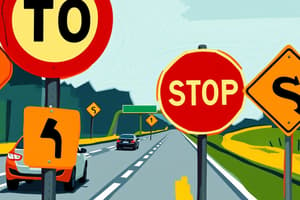Podcast
Questions and Answers
What is the recommended procedure for merging onto a highway from a ramp?
What is the recommended procedure for merging onto a highway from a ramp?
- Stay in the right lane at all times
- Merge directly into the left lane
- Merge into the right lane first and then gradually move left (correct)
- Immediately move into the left lane
What should you do before passing another vehicle on a highway?
What should you do before passing another vehicle on a highway?
- Check your blind spot and use your turn signal (correct)
- Drive close behind the vehicle in front
- Avoid using your turn signal
- Speed up without looking ahead
How can you ensure a safer driving experience during long highway drives?
How can you ensure a safer driving experience during long highway drives?
- Take breaks when needed and avoid distractions (correct)
- Regularly switch drivers to stay alert
- Drive continuously without stopping
- Engage in distracting activities like texting or eating
What is the importance of monitoring semi-trucks and large vehicles on highways?
What is the importance of monitoring semi-trucks and large vehicles on highways?
What is one of the responsibilities of a driver on the highway?
What is one of the responsibilities of a driver on the highway?
Which of the following is NOT a recommended practice for safe highway travel?
Which of the following is NOT a recommended practice for safe highway travel?
How should you react during emergency situations such as a flat tire on a highway?
How should you react during emergency situations such as a flat tire on a highway?
Why is using turn signals important when driving on the highway?
Why is using turn signals important when driving on the highway?
What should drivers do when they encounter debris on the highway?
What should drivers do when they encounter debris on the highway?
Why should drivers follow speed limits on highways?
Why should drivers follow speed limits on highways?
Flashcards are hidden until you start studying
Study Notes
Drivers' Role & Best Practices for Safe Highway Travel
Driving on highways requires a unique set of skills and knowledge. Here, we delve deeper into the role of drivers, discussing tips and best practices for navigating these busy thoroughfares safely and efficiently.
Understanding Your Role as a Driver
As a driver, you play a crucial role in ensuring the safety of yourself and others on the highway. Some of your responsibilities include:
- Familiarizing yourself with highway rules: Be aware of the specific laws that govern driving on highways, such as passing rules, lane changes, and merging procedures.
- Paying attention to traffic signals: Always obey traffic lights, signs, and markers along your route. Failure to do so can result in accidents or tickets.
- Following speed limits: Highways often have maximum and minimum speed limits. Make sure you're aware of these guidelines and adjust your driving accordingly.
- Using turn signals: Signal your intentions before changing lanes or turning onto or off the highway. This helps other drivers anticipate your moves and prevents collisions.
- Being alert for hazards: Keep an eye out for potential dangers like debris on the road, construction zones, or sudden stops caused by accidents ahead.
Best Practices for Highway Driving
To ensure safe and efficient travel on highways, follow these best practices:
Merge Correctly
When entering a highway from a ramp, merge into the right lane first, then gradually move into the left lane once it's clear. Use your blinker to signal your intentions and check your mirrors and blind spot for approaching vehicles.
Pass Safely
If you need to pass another vehicle, make sure there are no obstacles ahead, such as cars, trucks, or construction equipment. Check your blind spot and use your turn signal before passing. Once you've passed, return to your original lane.
Stay Alert & Focused
Long drives on highways can be tiring, but staying focused is critical. Take breaks when needed, switch drivers if possible, and avoid activities that distract you from the road, such as texting or eating while driving.
Monitor Your Surroundings
Keep an eye on the traffic around you, including semi-trucks and other large vehicles that may require more room to maneuver. Be mindful of their positions and actions, as they can impact the flow of traffic.
Don't Panic During Emergency Situations
Remain calm if you experience a flat tire, brake failure, or another emergency on the highway. Pull over safely if possible, activate your emergency flashers, and call for assistance if necessary. Remember, abrupt actions can cause accidents, so always plan ahead.
By following these guidelines and understanding your role as a driver on highways, you can help ensure a safer driving experience for everyone on the road.
Studying That Suits You
Use AI to generate personalized quizzes and flashcards to suit your learning preferences.




